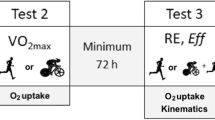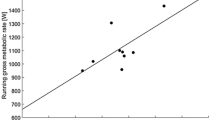Abstract
The aim of this study was to investigate the metabolic responses to variable versus constant-intensity (CI) during 20-km cycling on subsequent 5-km running performance. Ten triathletes, not only completed one incremental cycling test to determine maximal oxygen uptake and maximal aerobic power (MAP), but also three various cycle-run (C–R) combinations conducted in outdoor conditions. During the C–R sessions, subjects performed first a 20-km cycle-time trial with a freely chosen intensity (FCI, ∼80% MAP) followed by a 5-km run performance. Subsequently, triathletes were required to perform in a random order, two C–R sessions including either a CI, corresponding to the mean power of FCI ride, or a variable-intensity (VI) during cycling with power changes ranging from 68 to 92% MAP, followed immediately by a 5-km run. Metabolic responses and performances were measured during the C–R sessions. Running performance was significantly improved after CI ride (1118 ± 72 s) compared to those after FCI ride (1134 ± 64 s) or VI ride (1168 ± 73 s) despite similar metabolic responses and performances reported during the three cycling bouts. Moreover, metabolic variables were not significantly different between the run sessions in our triathletes. Given the lack of significant differences in metabolic responses between the C–R sessions, the improvement in running time after FCI and CI rides compared to VI ride suggests that other mechanisms, such as changes in neuromuscular activity of peripheral skeletal muscle or muscle fatigue, probably contribute to the influence of power output variation on subsequent running performance.


Similar content being viewed by others
References
Atkinson G, Davison R, Jeukendrup A, Passfield L (2003) Science and cycling: current knowledge and future directions for research. J Sports Sci 21:767–787
Bentley DJ, Millet GP, Vleck VE, MacNaughton LR (2002) Specific aspects of contempory triathlon. Sports Med 32:1–15
Bernard T, Vercruyssen F, Grego F, Hausswirth C, Lepers R, Vallier JM, Brisswalter J (2003) Effect of cycling cadence on subsequent 3-km running performance in well-trained triathletes. Br J Sports Med 37:154–159
Bijker KE, De Groot G, Hollander AP (2002) Differences in leg muscle activity during running and cycling in humans. Eur J Appl Physiol 87:165–170
Bishop D, Bonetti D, Dawson B (2002) The influence of pacing strategy on \(\dot{V}\hbox{O}_{2}\) and supramaximal kayak performance. Med Sci Sports Exerc 34:1041–1047
Borg GA (1970) Perceived exertion as an indicator of somatic stress. Scand J Rehabil Med 2:92–98
Borrani F, Candau R, Millet GY, Perrey S, Fuchslocher J, Rouillon JD (2001) Is the \(\dot{V}\hbox{O}_{2}\) slow component dependent on progressive recruitment of fast-twitch fibers in trained runners? J Appl Physiol 90:2212–2220
Brandon LJ (1995) Physiological factors associated with middle distance running performance. Sports Med 95:268–277
Citerrio G, Agostini E (1984) Selective activation of quadriceps muscle fibers according to bicycling rate. J Appl Physiol 57:371–379
Duc S, Betik AC, Grappe F (2005) EMG activity does not change during a time trial in competitive cyclists. Int J Sports Med 26:145–150
Gottschall JS, Palmer BM (2002) The acute effects of prior cycling cadence on running performance and kinematics. Med Sci Sports Exerc 34:1518–1522
Hausswirth C, Lehenaff D, Dreano P, Savonen K (1999) Effects of cycling alone or in a sheltered position on subsequent running performance during a triathlon. Med Sci Sports Exerc 31:599–604
Hausswirth C, Vallier JM, Lehenafff D, Brisswalter J, Smith D, Millet G, Dreano P (2001) Effect of two drafting modalities in cycling on running performance. Med Sci Sports Exerc 33:385–390
Jones SM, Passfield L (1998) The dynamic calibration of bicycle power measuring cranks. In: Haake Sj (ed) The engineering of sport. Blackwell, Oxford, pp 265–274
Lepers R, Millet GY, Maffiuletti N (2001) Effect of cycling cadence on contractile and neural properties of knee extensors. Med Sci Sports Exerc 33:1882–1888
Lepers R, Maffiuletti N, Rochette L, Brugniaux J, Millet GY (2002) Neuromuscular fatigue during a long-duration cycling exercise. J Appl Physiol 92:1487–1493
Liedl MA, David PS, Branchi JD (1999) Physiological effects of constant versus variable power during endurance cycling. Med Sci Sports Exerc 31:1472–1477
MacLaughlin JE, King GA, Howley ET, Basset DR, Ainsworth Jr BE (2001) Validation of Cosmed K4b2 portable metabolic system. Int J Sports Med 22:280–284
Marsh AP, Martin PE (1995) The relationship between cadence and lower extremity EMG in cyclists and noncyclists. Med Sci Sports Exerc 27:217–225
Noakes TD, St Clair Gibson A, Lambert EV (2004) From catastrophe to complexity: a novel model of integrative central neural regulation of effort and fatigue during exercise in humans: summary and conclusions. Br J Sports Med 39:120–124
Nummela AT, Paavolainen LM, Sharwood KA, Lambert MI, Noakes TD, Rusko HK (2006) Neuromuscular factors determining 5 km running performance and running economy in well-trained athletes. Eur J Appl Physiol 97:1–8
Paavolainen L, Nummela A, Rusko H, Hakkinen K (1999) Neuromuscular characteristics and fatigue during 10 km running. Int J Sports Med 20:516–521
Palmer GS, Noakes T, Hawley JA (1997) Effects of steady-state versus stochastic exercise on subsequent cycling performance. Med Sci Sport Exerc 29:684–687
Palmer GS, Borghouts LB, Noakes T, Hawley JA (1999) Metabolic and performance responses to constant-load vs. variable-intensity exercise in trained cyclists. J Appl Physiol 87:1186–1196
Perrey S, Candau R, Millet GY, Borrani F, Rouillon JD (2003) Physiological and metabolic responses of triathletes to a simulated 30-min time-trial in cycling at self-selected intensity. Int J Sports Med 24:138–143
Pyne DB, Boston T, Martin DT, Logan A (2000) Evaluation of the lactate pro blood lactate analyser. Eur J Appl Physiol 82:112–116
Ramsay RL, Davies PD, Sharp NCC (2001) The effect of variable power output during cycling on subsequent run performance in triathletes. Med Sci Sports Exerc 33S:S341
Sarre G, Lepers R (2005) Neuromuscular function during prolonged pedalling exercise at different cadences. Acta Physiol Scand 185(4):321–328
StClair Gibson A, Noakes TD (2004) Evidence for complex system integration and dynamic neural regulation of skeletal muscle recruitment during exercise in humans. Br J Sports Med 38:797–806
StClair Gibson A, Schabort EJ, Noakes TD (2001) Reduced neuromuscular activity and force generation during prolonged cycling. Am J Physiol Regul Integr Comp Physiol 281:R187–R196
Swain DP (1997) A model for optimizing cycling performance by varying power on hills and in wind. Med Sci Sports Exerc 29:1104–1108
Takaishi T, Yamamoto T, Ono TY, Moritani T (1996) Optimal pedaling rate estimated from neuromuscular fatigue for cyclists. Med Sci Sports Exerc 28:1492–1497
Vercruyssen F, Brisswalter J, Hausswirth C, Bernard T, Bernard O, Vallier JM (2002) Influence of cycling cadence on subsequent running performance in triathletes. Med Sci Sports Exerc 34:530–536
Vercruyssen F, Suriano R, Bishop D, Hausswirth C, Brisswalter J (2005) Cadence selection affects metabolic responses during cycling and subsequent running time to fatigue. Br J Sports Med 39:267–272
Acknowledgments
The authors gratefully acknowledge all the triathletes who took part in the experiment for their high cooperation and motivation.
Author information
Authors and Affiliations
Corresponding author
Rights and permissions
About this article
Cite this article
Bernard, T., Vercruyssen, F., Mazure, C. et al. Constant versus variable-intensity during cycling: effects on subsequent running performance. Eur J Appl Physiol 99, 103–111 (2007). https://doi.org/10.1007/s00421-006-0321-7
Accepted:
Published:
Issue Date:
DOI: https://doi.org/10.1007/s00421-006-0321-7




